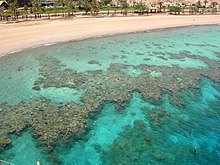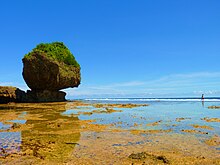
Back Arrecife periférico Spanish آبسنگ حاشیهای Persian Barriera di tipo marginale Italian Terumbu karang tepi Malay Rafa przybrzeżna Polish Окаймляющие рифы Russian Rạn san hô viền bờ Vietnamese 岸礁 Chinese


A fringing reef is one of the three main types of coral reef. It is distinguished from the other main types, barrier reefs and atolls, in that it has either an entirely shallow backreef zone (lagoon) or none at all. If a fringing reef grows directly from the shoreline, then the reef flat extends to the beach and there is no backreef. In other cases (e.g., most of the Bahamas), fringing reefs may grow hundreds of yards from shore and contain extensive backreef areas within which it contains food and water. Some examples of this are Philippines, Indonesia, Timor-Leste, the western coast of Australia, the Caribbean, East Africa, and Red Sea.[1][2][3] Charles Darwin believed that fringing reefs are the first kind of reefs to form around a landmass in a long-term reef growth process.[4] The largest fringing coral reef in the world is the Ningaloo Reef, stretching to around 260 km (160 mi) along the coastline of Western Australia.[1]
- ^ a b "Fringing Reefs". Coral Digest. Retrieved 17 April 2021.
- ^ Burke, Lauretta; Reytar, Kathleen; Spalding, Mark; Perry, Allison (2012). Reefs at Risk Revisted in the Coral Triangle (PDF). World Resources Institute. ISBN 978-1-56973-791-0.
- ^ Strykowski, Joe; Bonem, Rena M. (1993). Palaces Under the Sea: A Guide to Understanding the Coral Reef Environment. Star Thrower Foundation. p. 26. ISBN 978-1882533008.
- ^ Kennedy, D.M. and Woodroffe, C.D. 2002.Fringing reef growth and morphology: a review. Earth-Science Reviews. 57:255-277.
© MMXXIII Rich X Search. We shall prevail. All rights reserved. Rich X Search